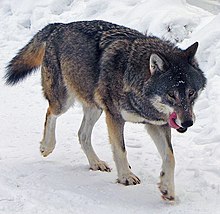| Eurasian wolf | |
|---|---|

| |
| In the Kolmården Wildlife Park, Sweden | |
| Scientific classification | |
| Domain: | Eukaryota |
| Kingdom: | Animalia |
| Phylum: | Chordata |
| Class: | Mammalia |
| Order: | Carnivora |
| Family: | Canidae |
| Genus: | Canis |
| Species: | |
| Subspecies: | C. l. lupus
|
| Trinomial name | |
| Canis lupus lupus | |

| |
| C. l. lupus range | |
| Synonyms | |
|
List
| |
The Eurasian wolf (Canis lupus lupus), also known as the common wolf,[3] is a subspecies of grey wolf native to Europe and Asia. It was once widespread throughout Eurasia prior to the Middle Ages. Aside from an extensive paleontological record, Indo-European languages typically have several words for "wolf", thus attesting to the animal's abundance and cultural significance.[4] It was held in high regard in Baltic, Celtic, Slavic, Turkic, ancient Greek, Roman, Dacian, and Thracian cultures, whilst having an ambivalent reputation in early Germanic cultures.[5]
It is the largest of Old World grey wolves, averaging 39 kg (86 lb) in Europe;[6] however, exceptionally large individuals have weighed 69–79 kg (152–174 lb), though this varies according to region.[7][8] Its fur is relatively short and coarse,[3] and is generally of a tawny colour, with white on the throat that barely extends to the cheeks.[8] Melanists, albinos, and erythrists are rare, and mostly the result of wolf-dog hybridisation.[9] According to Erik Zimen, the howl of the Eurasian wolf is much more protracted and melodious than that of North American grey wolf subspecies, whose howls are louder and have a stronger emphasis on the first syllable.[10]
Many Eurasian wolf populations are forced to subsist largely on livestock and garbage in areas with dense human activity, though wild ungulates such as moose, red deer, roe deer and wild boar are still the most important food sources in Russia and the more mountainous regions of Eastern Europe. Other prey species include reindeer, argali, mouflon, wisent, saiga, ibex, chamois, wild goats, fallow deer, and musk deer.[11]
- ^ "Wolf". eunis.eea europa.eu.
- ^ Wozencraft, W. C. (2005). "Order Carnivora". In Wilson, D. E.; Reeder, D. M. (eds.). Mammal Species of the World: A Taxonomic and Geographic Reference (3rd ed.). Johns Hopkins University Press. ISBN 978-0-8018-8221-0. OCLC 62265494.
- ^ a b Mech, L. David (1981), The Wolf: The Ecology and Behaviour of an Endangered Species, University of Minnesota Press, p. 354, ISBN 0-8166-1026-6
- ^ Gamkrelidze, T. V. & Ivanov, V. V. (1995), Indo-European and the Indo-Europeans: A Reconstruction and Historical Analysis of a Proto-Language and Proto-Culture, Walter de Gruyter, pp. 413-417, ISBN 3110815036
- ^ Cite error: The named reference
boitani2005was invoked but never defined (see the help page). - ^ "Factsheet: Gray Wolf (Eurasia's Carnivores > Canis lupus)". Archived from the original on 2015-08-04. Retrieved 2015-03-07.
- ^ Heptner, V. G. & Naumov, N. P. (1998) Mammals of the Soviet Union Vol.II Part 1a, SIRENIA AND CARNIVORA (Sea cows; Wolves and Bears), Science Publishers, Inc. USA., pp. 184-187, ISBN 1-886106-81-9
- ^ a b Miller, G. S. (1912), Catalogue of the mammals of Western Europe (Europe exclusive of Russia) in the collection of the British museum, London, Printed by order of the Trustees of the British Museum, pp. 313-314
- ^ Heptner, V. G. & Naumov, N. P. (1998) Mammals of the Soviet Union Vol.II Part 1a, SIRENIA AND CARNIVORA (Sea cows; Wolves and Bears), Science Publishers, Inc. USA., pp. 166, ISBN 1-886106-81-9
- ^ Zimen, E. (1981), The Wolf: His Place in the Natural World, Souvenir Press, p. 73, ISBN 0-285-62411-3
- ^ Peterson, R. O. & Ciucci, P. (2003), "The Wolf as a Carnivore", in Wolves: Behavior, Ecology, and Conservation, edited by L. David Mech and Luigi Boitani, pp. 104-130, Chicago: University Press
